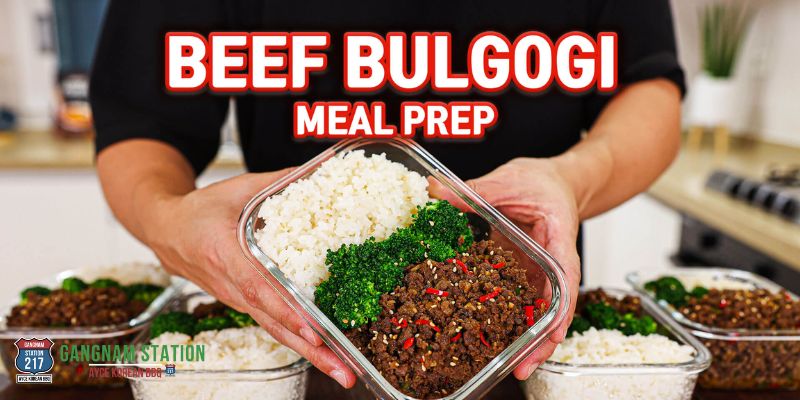
How to Cook Bulgogi: The Ultimate Guide to Perfecting Korean BBQ at Home
Bulgogi, one of Korea's most beloved dishes, is a staple in Korean BBQ cuisine. The term bulgogi translates to 'fire meat', reflecting the dish's traditional method of grilling marinated beef over an open flame. If you’ve ever been to a Korean BBQ restaurant like Gangnam Station Korean BBQ in Los Angeles or Buena Park, you’ve likely savored the sweet, savory, and smoky flavors that make bulgogi so irresistible.
In this guide, I’ll walk you through everything you need to know about bulgogi, from selecting the best cuts of meat to mastering the marinade and cooking techniques. Whether you're a seasoned chef or a beginner in the kitchen, this comprehensive guide will help you create a delicious bulgogi experience at home.
What is Bulgogi?
Bulgogi is a Korean dish typically made with thinly sliced beef marinated in a mixture of soy sauce, sugar, sesame oil, garlic, and other flavorful ingredients. The marinated meat is then grilled or pan-fried until tender and caramelized, resulting in a dish that's both sweet and savory with a hint of smokiness.
Historical Background and Cultural Significance:
The origins of bulgogi date back to the Goguryeo period (37 BC – 668 AD) when it was known as "maekjeok," a dish that involved grilling marinated meat on skewers. Over time, the recipe evolved, and by the Joseon Dynasty, it had become a beloved royal dish. Today, bulgogi is not only a popular meal in Korean households but also a dish that represents Korean culture worldwide.
Ingredients That Define Bulgogi:
The key to authentic bulgogi lies in its marinade, which typically includes soy sauce, sugar, garlic, sesame oil, and green onions. Some variations also incorporate fruits like Korean pear or apple to tenderize the meat and add a subtle sweetness. The choice of meat is also crucial, with rib-eye or sirloin being the most popular cuts due to their tenderness and flavor.
Choosing the Right Meat for Bulgogi
The success of your bulgogi largely depends on the quality of the meat you choose. Here’s how to select the best cuts for your bulgogi:
Preferred Cuts:
- Rib-Eye: Known for its marbling, rib-eye is a top choice for bulgogi. The fat content ensures that the meat stays juicy and flavorful during cooking.
- Sirloin: This leaner cut is also popular for bulgogi. It’s tender and absorbs the marinade well, making it a great option if you prefer less fatty meat.
- Tenderloin: For a melt-in-your-mouth texture, tenderloin is an excellent choice, though it may lack the robust flavor of rib-eye or sirloin.
Tips for Slicing Meat:
For bulgogi, the meat should be sliced as thinly as possible, ideally around 1/8 inch thick. Freezing the meat for about 30 minutes before slicing can make this task easier. The thin slices allow the marinade to penetrate deeply, ensuring every bite is packed with flavor.
Alternative Meats:
While beef is the traditional choice, bulgogi can also be made with pork, chicken, or even tofu for a vegetarian option. Each variation offers a unique twist on the classic dish, allowing you to experiment with different flavors and textures.
Crafting the Perfect Bulgogi Marinade
The marinade is the heart of any bulgogi dish. It infuses the meat with a rich, savory flavor that’s slightly sweet and deeply aromatic. Here's how to make the perfect bulgogi marinade:
Essential Ingredients:
- Soy Sauce: The base of the marinade, providing a salty and umami-rich flavor.
- Sugar or Honey: Adds sweetness and helps create the caramelized crust on the meat.
- Garlic and Ginger: Essential for depth and warmth, these ingredients are must-haves in Korean cooking.
- Sesame Oil: Adds a nutty aroma and richness to the marinade.
- Green Onions: For a fresh, mild onion flavor that complements the meat.
- Korean Pear or Apple (Optional): These fruits act as natural tenderizers and add a subtle sweetness to the dish.
Step-by-Step Marinade Preparation:
- Combine the Ingredients: In a bowl, mix soy sauce, sugar, minced garlic, grated ginger, and sesame oil. If using, add grated Korean pear or apple.
- Adjust to Taste: Taste the marinade and adjust the sweetness or saltiness according to your preference. The balance of flavors is crucial for an authentic bulgogi experience.
- Marinate the Meat: Place the thinly sliced beef in the marinade, ensuring every piece is well-coated. Marinate for at least 30 minutes, but for the best results, let it sit for a few hours or overnight in the refrigerator.
Common Mistakes to Avoid:
- Over-Marinating: While marinating overnight can enhance the flavor, leaving the meat in the marinade for too long can cause it to become too salty or mushy.
- Using Too Much Sugar: Although sweetness is a key component of bulgogi, too much sugar can overwhelm the other flavors. Aim for a balanced marinade where sweetness enhances rather than dominates the dish.
Cooking Methods: Grilling vs. Pan-Frying
Bulgogi can be cooked in various ways, each method offering a slightly different flavor and texture. The two most common methods are grilling and pan-frying.
Grilling Bulgogi:
Grilling is the traditional method for cooking bulgogi, and it imparts a smoky flavor that’s hard to replicate. Here’s how to do it:
- Preheat the Grill: Heat your grill to medium-high. If using a charcoal grill, allow the coals to become white-hot before cooking.
- Oil the Grates: To prevent the meat from sticking, lightly oil the grill grates before placing the meat.
- Grill the Meat: Place the marinated beef slices on the grill. Since the meat is thin, it cooks quickly—usually within 2-3 minutes per side. Look for a nice char on the edges, which adds to the flavor.
- Serve Immediately: Bulgogi is best served hot off the grill, so be ready to serve as soon as it’s done.
Pan-Frying Bulgogi:
If you don’t have access to a grill, pan-frying is an excellent alternative. This method allows you to cook bulgogi indoors while still achieving a delicious result.
- Heat a Pan: Use a heavy-bottomed pan, such as a cast-iron skillet, and heat it over medium-high heat.
- Cook in Batches: To avoid overcrowding the pan, cook the meat in small batches. This ensures that the beef browns evenly and develops a nice crust.
- Deglaze the Pan: After cooking the meat, you can deglaze the pan with a little water or additional marinade to create a quick sauce that can be drizzled over the bulgogi.
Which Method is Better?
Both methods have their merits. Grilling offers a more authentic taste with smoky undertones, while pan-frying is convenient and still delivers a deliciously caramelized exterior. If you’re a fan of Gangnam Station Korean BBQ, you might prefer the grilled version for its traditional flavor profile.
Serving Suggestions and Pairings
Bulgogi is incredibly versatile and can be served in various ways, depending on your preference and the occasion. Here are some popular serving ideas:
With Rice:
The classic way to enjoy bulgogi is with steamed white rice. The rice soaks up the savory juices from the meat, making each bite satisfying. For a healthier twist, you can serve bulgogi with brown rice or a mix of grains.
In Lettuce Wraps:
Lettuce wraps, or ssam, are a traditional Korean way to enjoy bulgogi. Simply take a leaf of red or green lettuce, add a piece of bulgogi, and top it with ssamjang (a spicy-sweet Korean dipping sauce) and a slice of garlic or chili for extra kick. Wrap it all up and enjoy!
With Noodles:
For a heartier meal, serve bulgogi over a bed of Korean sweet potato noodles (dangmyeon) or even ramen. The noodles absorb the marinade's flavors, creating a rich and comforting dish.
With Banchan (Side Dishes):
No Korean meal is complete without banchan. Popular side dishes to pair with bulgogi include kimchi, pickled radishes, and seasoned spinach. These sides add freshness and a variety of textures to the meal.
In a Korean BBQ Feast:
If you’re hosting a Korean BBQ at home, bulgogi is a must-have. Serve it alongside other grilled meats, such as samgyeopsal (pork belly) and galbi (short ribs), for a complete BBQ experience.
Health Benefits of Bulgogi
While bulgogi is undeniably delicious, it also offers some health benefits, especially when prepared with lean cuts of beef and served with plenty of vegetables.
High in Protein:
Beef bulgogi is a great source of protein, essential for muscle growth and repair. Depending on the cut of meat you use, it can also be relatively low in fat.
Rich in Vitamins and Minerals:
The marinade ingredients, such as garlic and ginger, provide additional health benefits. Garlic is known for its immune-boosting properties, while ginger can aid digestion and reduce inflammation.
Low-Carb Option:
When served with lettuce wraps instead of rice, bulgogi becomes a low-carb meal, suitable for those following a keto or low-carb diet.
Customization for Dietary Needs:
Bulgogi is highly adaptable to various dietary preferences. For a gluten-free version, simply use tamari or a gluten-free soy sauce. For a lower-sugar option, reduce the amount of sugar in the marinade or use a sugar substitute.
Final Thoughts: Bringing Bulgogi to Your Table
Bulgogi is more than just a dish; it’s an experience that brings people together, whether at home or at a place like Gangnam Station Korean BBQ. With this guide, you now have everything you need to cook bulgogi like a pro. From selecting the perfect cut of meat to mastering the marinade and cooking techniques, you’re well on your way to creating an authentic Korean BBQ experience right in your own kitchen.
So why not gather some friends, fire up the grill or stovetop, and share the joy of bulgogi? Whether it’s your first time making this dish or you’re a seasoned bulgogi fan, the flavors and aromas are sure to leave a lasting impression.
Remember, the key to great bulgogi is patience and attention to detail. With practice, you’ll find your own rhythm and style in making this beloved Korean dish. Happy cooking!

